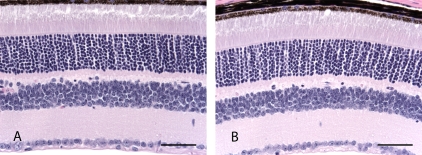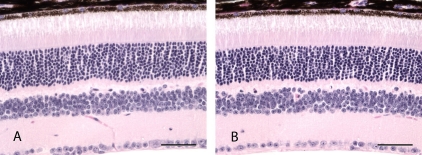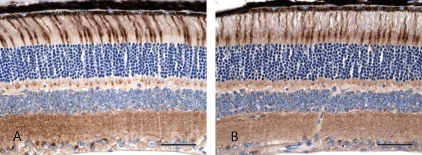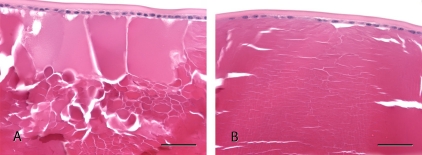Abstract
Various subtypes of the acid sensing ion channel have been detected in the retina of rodents and other mammalian species, but the functional importance of this finding is not clearly understood. The purpose of the study was to determine if retinal degeneration was present in ASIC1a-/- mice. The eyes of ASIC1a-/- mice, heterozygote ASIC1a+/- mice, and wild type ASIC1a+/+ mice that were 5 or 22-27 weeks old were processed by routine histotech-nological methods and examined for histologic changes in the retina and other portions of the eye. Additional sections of eyes from ASIC1a-/- and ASIC1a+/+ mice were labeled with peanut agglutinin (PNA) to evaluate cone pho-toreceptors. The retinas of ASIC1a-/-, ASIC1a+/-, and ASIC1a+/+ mice at 5 or 22-27 weeks of age were unremarkable and no morphologic changes in cone photo receptors were detected. Additional findings detected in the eye of ASIC1a+/+ mice included swelling of lens fibers or cataract that were also detected in some of the ASIC1a-/- or ASIC1a+/- mice. Lenticular findings were not considered to be associated with an absence of ASIC1a.
Keywords: ASIC1a, knockout mice, retina, acid-sensing ion channel
Introduction
Neurons contain acid sensing ion channels (ASICs) that are activated by extracellular acid. Several ASIC subunits, such as ASIC1a, ASIC2a, ASIC2b and ASIC3, are thought to be involved in the function of the retina (Lilley et al., 2004). ASIC3 occurs in rod inner segments, horizontal cells and amacrine cells (Ettaiche et al, 2009). Knockout mice for ASIC3 have alterations in their electroretinogram (ERG) at approximately 3 months of age and retinal degeneration involving rods by 18 months of age. ASIC2a and ASIC2b are present in photoreceptors and cause changes in the ERG (Ettaiche et al, 2004). Knockdown of ASIC1a by antisense oli-gonucleotides and in vivo blocking of activity by psalmotoxin (PcTx1) has been reported to cause a decrease in the a- and b-waves of the ERG and a decrease in oscillatory potentials (Ettaiche et al, 2006). It is unknown if a lack of ASIC1a causes morphologic changes in the retina.
ASIC1a has been proposed as a therapeutic target for a number of indications including pain, depression and stroke. In order to establish if there may be retinal liabilities associated with targeting ASIC1a as a potential therapy, eyes and other tissues of ASIC1a-/- and ASIC1a+/- mice were examined by routine light microscopy to determine if there were any morphologic changes that can be associated with the an absence of ASIC1a. Tissues from ASIC1a+/+ mice were examined for comparative purposes.
Materials and Methods
Animals
The study involved 30 mice: 5 male ASIC1a+/+, 5 male ASIC1a-/- mice and 5 male ASIC1a+/-mice at 5 weeks and at 22-27 weeks of age. We chose these ages to evaluate for possible progression of pathogenesis over time. Any possible histological changes at 5 weeks would be expected persist until later ages; or worsen if the pathology were progressive. All mice were maintained in a congenic c57Bl/6J genetic background.
Histology
The eyes of male ASIC1a+/+, ASIC1a-/-, and ASIC1a+/- mice at 5 weeks or 22-27 weeks of age were examined by use of routine light microscopy. Immediately after euthanasia, the eyes were enucleated and submerged in Davidson's fixative for approximately 24 hours followed by fixation in 10% neutral buffered formalin (NBF) for at least 24 hours. The eyes were maintained in 10% NBF while being sent to the Investigative Pathology Laboratory, DSRD, Pfizer, Inc, Groton, CT for processing and embedding in paraffin blocks. Embedded eyes were sectioned along a mid sagittal plane and sections were stained with hematoxylin and eosin, and examined by light microscopy.
Immunohistochemistry
The right eyes of ASIC1a+/+ and ASIC1a-/-mice were sectioned at 5 μm and adhered to positively charged glass slides. The cone photo-receptors were detected by immunohistochemistry using the Ventana Discovery XT (Ventana Medical Systems, Inc.; Tucson, AZ) automated staining platform. Following deparaffinization and pretreatment with CC2 (a low pH antigen retrieval) and heat to expose epitopes, nonspecific binding was blocked using avidin, bio-tin, and serum solutions. Cone photoreceptors were labeled with a cone-specific biotinylated lectin from Arachis hypogaea, peanut agglutinin (PNA; 0.1 mg/ml, Sigma-Aldrich, St. Louis, MO) and were detected using horseradish peroxi-dase-conjugated streptavidin and DAB chroma-gen. Following counterstaining with Mayer's He-matoxylin, the sections of retina were examined by light microscopy.
Results
The morphologic appearance of the retina of ASIC1a-/- mice at 5 weeks of age and at 22-27 weeks of age were similar to the morphologic appearance of same age ASIC1a+/+ and ASIC1a+/- mice (Figures 1 and 2). Changes, such as degeneration of rods and disorganization of the retinal architecture, were not observed.
Figure 1.
Histologic appearance of the central retina of mice at 5 weeks of age. (A) Normal appearing central retina of an ASIC1a+/+ mouse. (B) Normal appearing central retina of an ASIC1a-/- mouse. H&E stain. Bar = 50 |jm. ASIC1a+/- mice also had normal appearing central retina histology (not shown).
Figure 2.
Histologic appearance of the central retina of mice. (A) Unremarkable central retina of an ASIC1a+/+ mouse at 23 weeks. (B) Unremarkable central retina of an ASIC1a-/- mouse at 22 weeks. H&E stain. Bar = 50 μm. ASIC1a+/- mice had similar appearance (not shown).
The labeling of cone photoreceptors with PNA was similar between ASIC1a+/+ and ASIC1a-/-mice as shown in Figure 3. There were no apparent differences in the morphologic appearance and no decrease in the number of PNA-labeled photoreceptors in the ASIC1a-/- mice. Cone photoreceptors in ASIC1a-/- mice appeared unremarkable.
Figure 3.
Immunohistochemical staining of cone photo receptors in the central retina of mice with PNA. (A) Unremarkable cones in the central retina of an ASIC1a+/+ mouse at 23 weeks. (B) Unremarkable cones in the central retina of an ASIC1a-/- mouse at 22 weeks. Bar = 50 μm.
Other ocular structures were unremarkable, except for the lens. Most of the lenses examined of ASIC1a+/+, ASIC1a+/-, and ASIC1a-/-mice were unremarkable. However, an ASIC1a+/+ mouse at 23 weeks of age and a ASIC1a+/- mouse at 24 weeks of age had a focal, unilateral cataract as shown in Figure 4A. These areas were characterized by liquefaction and globule formation in the anterior cortex along with some swelling of lens fibers. In the lenses of other mice there was slight to minimal swelling of lens fibers in the anterior cortex as shown in Figure 4B. This finding occurred as a unilateral finding in 1/5 ASIC1a+/+, 2/5 ASIC1a+/- and 1/5 ASIC1a-/- mice at 5 weeks of age and in 3/5 ASIC1a+/+, 2/5 ASIC1a+/- and 1/5 ASIC1a-/- mice at 22-27 weeks of age. Lenticular changes in ASIC1a-/-mice were similar to those occurring in ASIC1a+/- and ASIC1a+/+ mice and were regarded as background changes that were unas-sociated with an absence of ASIC1a.
Figure 4.
Histologic appearance of the anterior lens of mice. (A) A focal, minimal, unilateral area of liquefaction and globule formation in the anterior cortex of the lens of an ASIC1a+/+ mouse at 23 weeks. (B) Slight swelling of lens fibers in the anterior cortex of the lens of ASIC1a-/- mouse at 27 weeks of age. H&E stain. Bar = 50 μm.
Discussion
It is reported that ASIC1a plays a role in the function of the retina. Knockdown of ASIC1a by antisense oligonucleotides and in vivo blocking of activity by PcTx1 was reported to cause a decrease in the a- and b-waves of the ERG and a decrease in oscillatory potentials in adult Brown Norway rats (Ettaiche et al, 2006). This work does not test retinal function and it is unknown if a lack of ASIC1a causes decreases in the a- and b-waves of the ERG and oscillatory potentials, but results of the current study indicate that a deficiency of ASIC1a does not appear to cause morphologic changes in the retina of mice 5 to 27 weeks old. Loss of ASIC3 (in ASIC3-/- mice) didn't result in retinal degeneration until the mice were 12 months old (Ettaiche et al, 2009). The retinas of ASIC3-/-mice at 12 months had disorganization of the outer nuclear layer, outer segments and inner segments with a reduction of nuclei in the outer nuclear layer. Degenerative changes in the photoreceptors appeared to be worse at 16 months. It remains unknown if retinal degeneration may occur as a delayed effect in older ASIC1a-/- mice.
Acknowledgments
The authors thank Margaret Wilhelms, Tania Franks and Walt Bobrowski of the Investigative Pathology Laboratory, Drug Safety R&D, Pfizer Inc, Groton, CT for their technical assistance.
References
- 1.Chang B, Dacey MS, Hawes NL, Hitchcock PF, Milam AH, Atmaca-Sonmez P, Nusinowitz S, Heckenlively JR. Cone photoreceptor function loss-3, a novel mouse model of achromatopsia due to a mutation in Gnat2. Invest Ophthalmol Vis Sci. 2006;47:5017–5021. doi: 10.1167/iovs.05-1468. [DOI] [PubMed] [Google Scholar]
- 2.Ettaiche M, Deval E, Cougnon M, Lazdunski M, Voilley N. Silencing acid-sensing ion channel 1a alters cone-mediated retinal function. J Neurosci. 2006;26:5800–5809. doi: 10.1523/JNEUROSCI.0344-06.2006. [DOI] [PMC free article] [PubMed] [Google Scholar]
- 3.Ettaiche M, Deval E, Pagnotta S, Lazdunski M, Lingueglia E. Acid-sensing ion channel 3 in retinal function and survival. Invest Ophthalmol Vis Sci. 2009;50:2417–2426. doi: 10.1167/iovs.08-3028. [DOI] [PubMed] [Google Scholar]
- 4.Ettaiche M, Guy N, Hofman P, Lazdunski M, Waldmann R. Acid-sensing ion channel 2 is important for retinal function and protects against light-induced retinal degeneration. J Neurosci. 2004;24:1005–1012. doi: 10.1523/JNEUROSCI.4698-03.2004. [DOI] [PMC free article] [PubMed] [Google Scholar]
- 5.Jeon CJ, Strettoi E, Masland RH. The major cell populations of the mouse retina. J Neurosci. 1998;18:8939–8946. doi: 10.1523/JNEUROSCI.18-21-08936.1998. [DOI] [PMC free article] [PubMed] [Google Scholar]
- 6.Lilley S, LeTissier P, Robbins J. The discovery and characterization of a protongated sodium current in rat retinal ganglion cells. J Neurosci. 2004;24:1013–1022. doi: 10.1523/JNEUROSCI.3191-03.2004. [DOI] [PMC free article] [PubMed] [Google Scholar]






